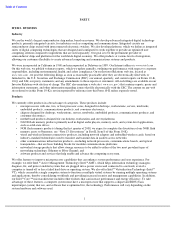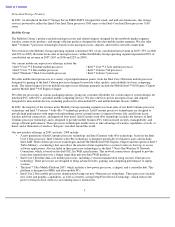Intel 2007 Annual Report Download - page 16
Download and view the complete annual report
Please find page 16 of the 2007 Intel annual report below. You can navigate through the pages in the report by either clicking on the pages listed below, or by using the keyword search tool below to find specific information within the annual report.
Table of Contents
We believe that our network of manufacturing facilities and assembly and test facilities gives us a competitive advantage. This
network enables us to have more direct control over our processes, quality control, product cost, volume, timing of production,
and other factors. These facilities require significant up-front capital spending, and many of our competitors do not own such
facilities because they may not be able to afford to do so or because their business models involve the use of third-party
facilities for manufacturing and assembly and test. These “fabless semiconductor companies” include Broadcom Corporation,
NVIDIA Corporation, QUALCOMM Incorporated, and VIA Technologies, Inc. (VIA). Some of our competitors own portions
of such facilities through investment or joint-venture arrangements with other companies. A group of foundries and assembly
and test subcontractors offer their services to companies that do not own facilities or to companies needing additional capacity.
These foundries and subcontractors may also offer intellectual property, design services, and other goods and services to our
competitors. Competitors who outsource their manufacturing and assembly and test operations can significantly reduce their
capital expenditures.
We plan to continue to cultivate new businesses and work with the computing and communications industries through
standards bodies, trade associations, OEMs, ODMs, and independent software and operating system vendors to help align the
industry to offer products that take advantage of the latest market trends and usage models. We frequently participate in
industry initiatives designed to discuss and agree upon technical specifications and other aspects of technologies that could be
adopted as standards by standards-setting organizations. Our competitors may also participate in the same initiatives and
specification development. Our participation does not ensure that any standards or specifications adopted by these
organizations will be consistent with our product planning.
Microprocessors
We continue to be largely dependent on the success of our microprocessor business. Our ability to compete depends on our
ability to deliver new microprocessor products with improved overall performance and/or improved energy-efficient
performance at competitive prices. Some of our microprocessor competitors, such as Advanced Micro Devices, Inc. (AMD),
market software-compatible products that compete with our processors. We also face competition from companies offering
rival architecture designs, such as Cell Broadband Engine Architecture developed jointly by International Business Machines
Corporation (IBM), Sony Corporation, and Toshiba Corporation; Power Architecture* offered by IBM; ARM architecture
(Advanced RISC Machine) developed by ARM Limited; and Scalable Processor Architecture (SPARC*) offered by Sun
Microsystems, Inc.
The following is a list of our main microprocessor competitors by market segment:
Chipsets
Our chipsets compete in the various market segments against different types of chipsets that support either our microprocessor
products or rival microprocessor products. Competing chipsets are produced by companies such as AMD (including chipsets
marketed under the ATI Technologies, Inc. brand), NVIDIA, Silicon Integrated Systems Corporation (SIS), and VIA.
We also compete with companies offering graphics components and other special-purpose products used in the desktop,
mobile, and enterprise market segments. One aspect of our business model is to incorporate improved performance and
advanced properties into our microprocessors and chipsets, the demand for which may increasingly be affected by competition
from companies, such as NVIDIA, whose business models are based on incorporating improved performance into dedicated
chipsets and other components, such as graphics controllers.
Flash Memory
Our NAND flash memory products currently compete with NOR and NAND products primarily manufactured by Hynix
Semiconductor Inc., Samsung Electronics Co., Ltd., SanDisk Corporation, Spansion Inc., STMicroelectronics, and Toshiba.
Connectivity
We offer products designed for wired and wireless connectivity; for the communications infrastructure, including network
processors; and for networked storage. Our WiFi and WiMAX products currently compete with WiFi products manufactured
by Atheros Communications, Inc. and Broadcom, and products manufactured by QUALCOMM.
11
•
Desktop:
AMD and VIA
•
Mobile:
AMD and VIA
•
Enterprise:
AMD, IBM, and Sun Microsystems
•
Embedded:
AMD, Freescale Semiconductor, Inc., and VIA
























